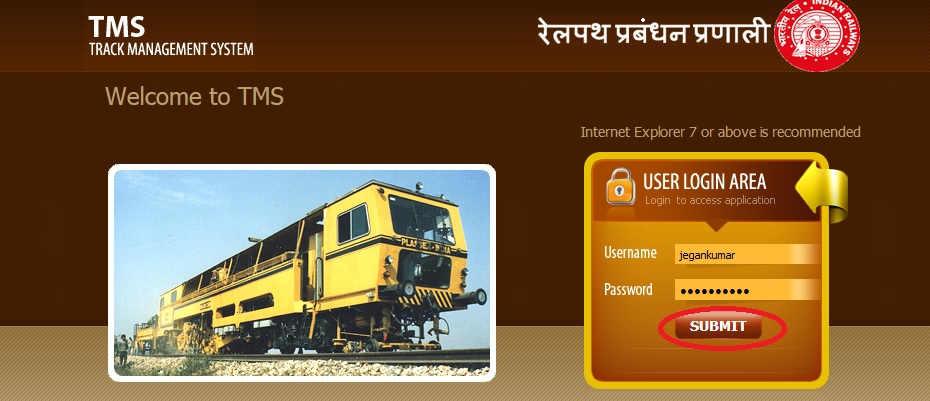ircep.gov.in TMS Track Management System : Indian Railways
Organisation : Indian Railways Civil Engineering Portal
Facility : Track Management System – TMS
Website : https://ircep.gov.in/TMS/
| Want to ask a question / comment on this post? Go to bottom of this page. |
|---|
How To Login To IRCEP Track Management System?
Go to the official website,click on Login Page. To check IRCEP Track Management System (TMS).
Related / Similar Service :
IRCEP Crossing Railway Line Online Application
1. Enter your Username
2. Enter Password
3. Click on Login button.

Note :
Member users can logon to their respective applications through this portal.
IRCEP PSAMS
Guidelines for applying for private siding and viewing the status of same :
** Click on the link “Apply Online”.
** Fill the particulars and save the application. A Proposal ID will be generated which is to be used subsequently for any reference or online query/status viewing.
** Print the duly filled form, sign on every page and submit to CTPM of concerned Zonal Railways along with Demand Draft for application fee of Rs. 20,000/- (in case of PFT application fee is Rs. 10,00,000/-).
** Demand Draft for application fee should be prepared in favour of FA&CAO of the concerned Zonal Railways payable at the Zonal Railway Head Quarter City.
** Application form not signed by applicant on each page or/and without application fee shall be considered incomplete and summarily be rejected.
** The formal registration will be done by CTPM after receipt of application form duly signed and with application fee. There after status of the proposal can be viewed online using the Proposal ID.
Indian Railways
Indian Railways is the life-line of nation providing transportation facility over the length and breadth of country.
It’s vision is to provide efficient, affordable, customer-focused, environmentally sustainable integrated transportation solutions and to be the vehicle of inclusive growth, connecting regions, communities, ports and centers of industry, commerce, tourism and pilgrimage across the country.
Civil Engineering infrastructure is the largest static infrastructure of Indian Railways comprising of track, bridges, land, etc. Management of this huge infrastructure has to be done in accordance with the organization’s vision.
Civil engineering department of Indian Railways manages and maintains all these infrastructures. Further, it has key role in the area of infrastructure development, technological leap in various fields, high speed travel and development of world class stations.
Indian Railways Track & Bridges
As on 31.03.2009, the route length of Indian Railways covered 64,015 kms. With running track length of 86,937 kms. The total trackage including yards, sidings etc. stood at 113,115 kms. The table below shows the changing size of IR’s rail network over the years.
Bridges :
IR has 1,30,776 bridges, out of which 670 are important, 10,724 are major and 1,19,382 are minor bridges. In 2008-09, 1,388 bridges including 36 distressed bridges were rehabilitated/rebuilt.
Road Over/Under Bridges :
To improve the safety and reduce inconvenience to road users, busy level crossings are being replaced by Road Over/Under Bridges (ROBs/RUBs) gradually.
The works of ROBs/RUBs in lieu of busy level crossings are sanctioned on cost sharing basis with the concerned State Governments/Local Authorities. During the year, a total of 38 works were completed on Zonal Railways.
As on 31st March, 2009 there are total 1,337 ROBs/RUBs works at various stages of planning and execution, out of which, 830 are sanctioned on cost sharing basis, 195 on deposit terms, 52 on Build Operate and Transfer (BOT) basis and 260 under NHDP and being constructed by NHAI as single entity.
Level crossings :
As on March 31,2009, IR maintained 34,220 level crossings, out of which 17,244 had gate-keepers and 16,976 crossings were unmanned. In 2008-09, 259 unmanned level crossings were provided with gate keepers.
Land Management :
IR owns about 4.31 lakh hectares of land, which is mainly used for locating operational and services infrastructure such as track, stations, workshops, staff colonies, etc.
Benefits of the IRCEP TMS
The IRCEP TMS has a number of benefits, including:
** Improved track safety: The TMS helps to identify and correct track defects before they cause accidents.
** Increased efficiency: The TMS helps to streamline the track maintenance process, making it more efficient and cost-effective.
** Improved asset management: The TMS helps to track the condition of track assets, such as sleepers and rails, so that they can be replaced or repaired before they fail.
** Improved decision-making: The TMS provides railway engineers with data and analysis that can be used to make better decisions about track maintenance and operations.